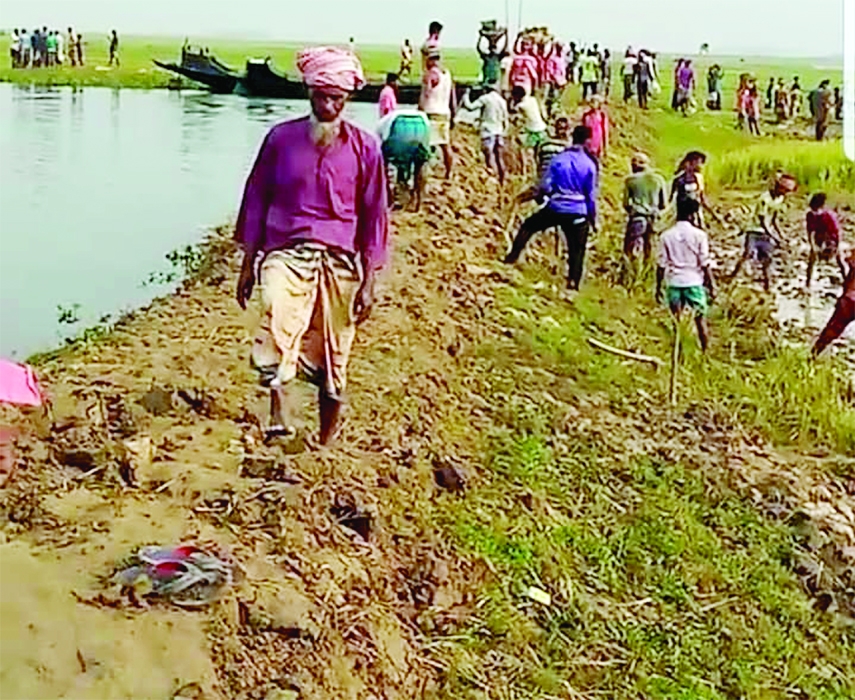
Staff Reporter, Kishoreganj :
The government invests a significant amount of public money to construct and repair levees in the haor region of the country’s north-eastern districts are Kishorganj, Netrokona, Sunamganj and Sylhet to protect the Boro paddy harvest from the flash floods following incessant rainfall in India ‘s bordering hilly areas have largely inundated their fields.
However, haor peoples suffer for years because of poor and Sub–standerd work.
Semi-ripe and raw boro paddy in haor area of Kishoreganj, Netrokona, and Sunamganj have been submerged due to the slope coming down from upstream.
In fear of crop loss, the haor peoples mandate are rushing to cut the semi-ripe paddy. Thousands of farmers are at risk of crop damage. They are frightened when they see clouds in the sky.
Several crop protection dams in the haor are under threat of flooding. To handle the situation, the farmers are trying to protect the crop with spade and khadi on their own initiative. There is a call to protect the land by hauling the paddy and filling it with soil even after miking in the mosque.
According to the locals, the crops of Afanna and Naluwar beels of Itna’s Dhanpur union of Kishoreganj have been damaged due to the hill slope and rain water coming from upstream for two days. Besides, Ershad Nagar, Chira Gang, Balda of Itna Sadar; Emerging semi-ripe and raw paddy lands in several areas including Elangjuri, Kulivita, Chilani, Bahirchar, Pangasia, Jeol’s haor have been submerged.
The Itna Joysiddhi Dam, a few dams including the Jiul Dam are under threat due to water pressure. Upazila administration and local people’s representatives are working to protect the dam in collaboration with local farmers.
Water Development Board (WDB) has taken all necessary measures to deal with the situation in the risky areas. The Department of Agricultural Extension is also inspecting the submerged paddy lands and areas to assess the damage.
Itna sadar Union Parishad (UP) Chairman Md. Sohag Mia said that, Several hectares of boro crop land had already been submerged. Apart from this,
Halal Dam, Jur Beel Dam and Jiul Dam are also under threat due to water pressure. There is a risk of extensive damage if water enters through these dams. A concerted effort is being made with the farmers to protect the crops.
Due to 26 mm of rain in Meghalaya and Assam of India, the upstream water level has come down to the haor of Kishoreganj through the emptiness of Sunamganj and Netrokona.
According to the farmers, thousands of hectares of paddy land have been submerged. However, the Itna Agriculture Department said that about 300 hectares of paddy land had been damaged till Monday afternoon. Most of these are lands along various canals and rivers. The main dam has not yet overflowed or broken. Local farmer Bakul Mia said 40 per cent of his paddy land was submerged on Sunday night.
Farmer Mamun Mia has 50 per cent and Faizul Mia has about 4 acres of paddy land under water. In such a situation, many farmers have started cutting half-ripe paddy in a hurry.
Itna Upazila Agriculture Officer Ujjwal Saha said that due to 26 mm of rain in Meghalaya and Assam in India, the upstream water level has come down in Sunamganj, Netrokona and Kishoreganj haor. So far about 300 hectares of paddy land has been damaged. Most of the damage was in Afanna and Naliya beels of Dhanpur area. He is currently staying there.
According to the Agriculture Extension Department (AED) in Kishoreganj, the target for boro cultivation in 13 upazilas of Kishoreganj this year is 1 lakh 64 thousand 465 hectares. The target has been set at 1 lakh 6 thousand 190 hectares. Of these, 1 lakh 3 thousand 940 hectares have been cultivated in haor areas l alone. And upstream areas outside the haor have been cultivated in 73,250 hectares of land.
Water Development Board (WDB) in Kishoreganj, Executive Engineer Matiur Rahman said that heavy rains have started in Cherrapunji of India since last Saturday, the rain water came to the Dhanu and Ghorautra rivers of Kishoreganj at high speed through Khaliajuri of Netrokona district and suddenly the water level increased by 6 to 8 feet. As a result, some canal-beel lands along the river have been submerged. However, water has not yet entered the main haors. He and his office officials are monitoring the situation at Itner Haor. However, the relief is that Mithamin and Ashtagram in haors l have not had this problem so far.
Deputy Director of the Department of Agricultural Extension. Saiful Alam told the New Nation that the officials of the agriculture department are in the field to see the situation in the haor. The main haor is still safe. Within a week, BRI-28 variety of paddy will be harvested and within a month, all the paddy will be harvested in full swing. Farmers will be able to harvest their dreams at home.

